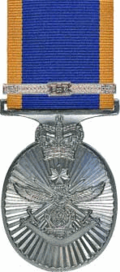| Reserve Force Medal | |
|---|---|
 Obverse of medal (with bar) and ribbon | |
| Type | Long Service Medal |
| Awarded for | a minimum of 15 years "qualifying service", including an assessment of good conduct |
| Presented by | Australia |
| Eligibility | Non-commissioned members of the Australian Defence Force Reserves |
| Clasps | for each additional 5 years of service |
| Status | Not currently awarded, but additional service bars can still be issued to awardees |
| Established | 20 April 1982 |
| Total | 12,000 [1] |
| Ribbon with rosette | |
| Order of Wear | |
| Next (higher) | Reserve Force Decoration (RFD) [2] |
| Next (lower) | Defence Long Service Medal [2] |
The Reserve Force Medal (RFM) is an Australian Military award given for long service by non-commissioned members of the Reserve Forces. It is part of the suite of defence force service awards introduced in 1982, which also included the Defence Force Service Medal (DFSM, for all members of the permanent forces) and the Reserve Force Decoration (RFD, for officers of the Reserve forces).
Contents
All three medals were replaced with effect 20 April 1999 with a single medal, the Defence Long Service Medal, [3] [4] [5] which is now awarded to all permanent and reserve members irrespective of rank. [6]
Additional service clasps, each indicating a further 5 years after the initial 15 year qualifying service, can still be issued to persons awarded the RFD, RFM or DFSM. The first four clasps to the medal are indicated by rosettes. These are replaced by a single silver Federation Star for the fifth clasp. Additional Federation Star emblems are added for subsequent clasps.